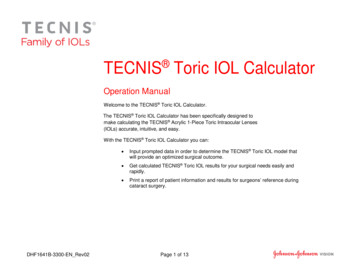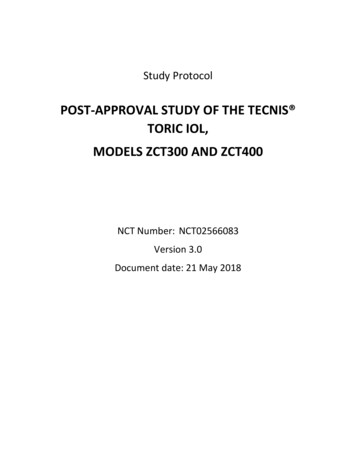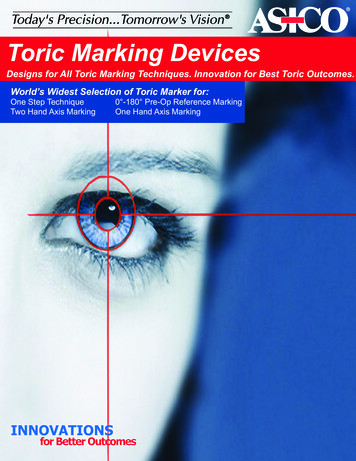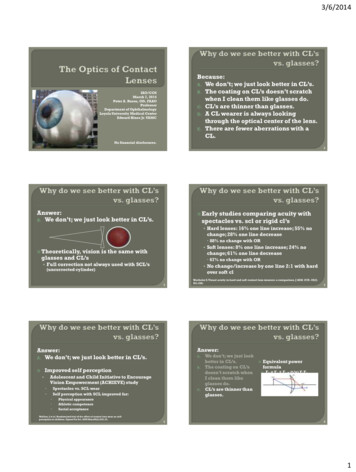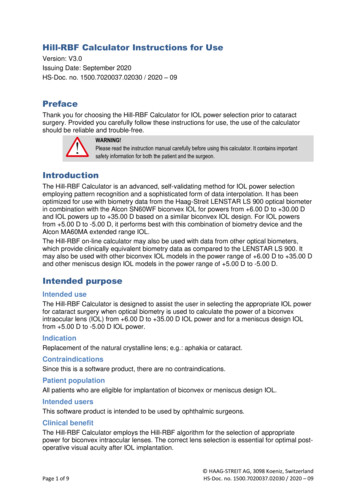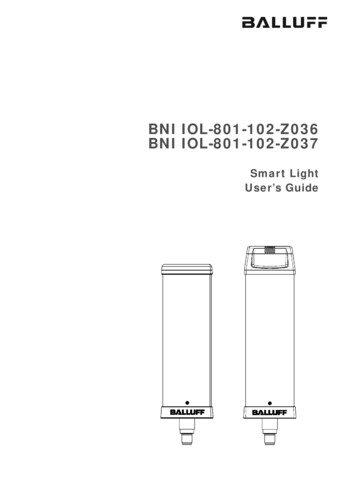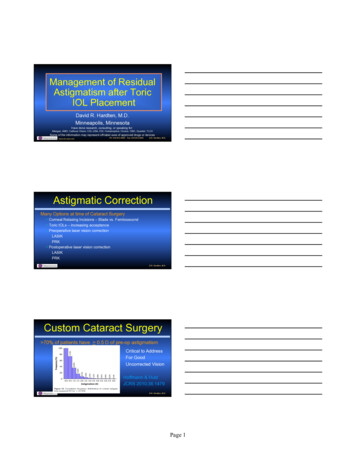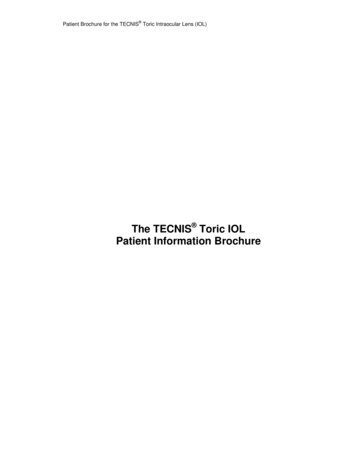
Transcription
Patient Brochure for the TECNIS Toric Intraocular Lens (IOL)The TECNIS Toric IOLPatient Information Brochure
Patient Brochure for the TECNIS Toric Intraocular Lens (IOL)Table of ContentsIntroduction . 1What is corneal astigmatism? . 1What is a cataract? . 1What to expect during cataract surgery . 2What to expect after cataract surgery . 3Choosing the implant best for your vision . 3Risks. 3Warnings . 3Precautions. 4Making the right choice . 4What this means to you . 7
Patient Brochure for the TECNIS Toric Intraocular Lens (IOL)IntroductionIf you have a cataract, don’t worry. You’re not alone. Every year, nearly 2,500,000Americans have cataract surgery. It is one of today’s safest and most successfulprocedures. This brochure is designed to help you and your eye doctor decide on thebest type of treatment choice for you. If you have questions about cataract surgery orany of the information in this brochure, please ask your eye doctor.What is corneal astigmatism?Astigmatism is a focusing error in the eye. It results in blurred distance and/or nearvision. In a normal eye, the cornea (clear front cover of the eye) has a round shape (likea basketball). This allows the light rays that enter the eye to focus on the back of the eye(retina) and make a clear image. In an eye with corneal astigmatism, the cornea has anoblong shape (like an American football). As a result, the light rays do not focus at thesame point on the retina and parts of an object may not appear clear. High levels ofcorneal astigmatism may also be associated with visual distortions (e.g. objects appeartilted or misshapen or floors appear curved). During your eye exam, your eye doctor willbe able to tell you if you have corneal astigmatism.What is a cataract?Inside your eye is a natural lens that helps focus light. The lens creates images in theback of your eye like a camera focuses images on film (Figure 1). As people age, thelens can become less clear, even cloudy. This cloudiness in the lens is called acataract. Just as a dirty camera lens can spoil a picture, a cataract can prevent lightfrom focusing clearly inside the eye. Typical signs of cataracts are blurred vision andsensitivity to light. For example, you may have trouble reading, or driving at night or atdusk. Colors may seem less vivid and it may be difficult to thread a needle, shave or puton makeup.Page 1
Patient Brochure for the TECNIS Toric Intraocular Lens (IOL)Figure 1: Diagram of eye with intraocular lens implantWhat to expect during cataract surgeryThe most common treatment today is to remove the clouded natural lens and replace itwith an artificial lens. The artificial lens is called an intraocular lens, or “IOL”. Figure 2compares the size of the TECNIS Toric IOL to a U.S. penny.Figure 2: Size comparison of TECNIS Toric IOL and U.S. pennyWhen you and your eye doctor agree to proceed with your cataract surgery, you willhave an evaluation before surgery. This includes checking for any eye diseases andmeasuring your eye to select the correct lens power. Be sure to tell your eye doctor ifyou have any health conditions that may affect your surgery or vision and provide anupdated list of medications to your doctor.Cataract surgery is usually done as an outpatient procedure. You will be givenanesthesia in the form of eye drops to numb your eye. Typically, you will be fully awakeduring the surgery but you will be comfortable and should feel little or no discomfort. Toremove the cataract, your surgeon will first make a tiny incision in your eye. Then, avery small probe will be inserted so the cataract can be broken into little pieces. Next,the probe will be used to vacuum out the cataract pieces. Now there will be room for theintraocular lens to be placed in your eye. The surgeon will insert the lens through thesame tiny incision. When the surgery is complete, your eye doctor may place aprotective patch or shield over your eye. Right after surgery, you should remain in therecovery area for a short time. You should make plans to have someone else drive youhome.Page 2
Patient Brochure for the TECNIS Toric Intraocular Lens (IOL)What to expect after cataract surgeryAfter your operation, your eye doctor should give you an identification card to keep inyour wallet. This card shows the type of implant in your eye. You should present thiscard to any eye doctor who examines your eyes after your surgery.You will be given a date and time for a follow-up appointment with your eye doctor.Typically, your eye doctor will examine you the following day. Your doctor will examineyou several more times following your surgery. Many patients may begin to see betterwithin 1 to 2 days, more are stable at 10 to 14 days. Some may take 4 to 6 weeks torecover from surgery. Improvements in vision are different for each individual.Your doctor may prescribe eye drops and/or medicines after surgery. Take all prescribedmedicines and apply antibiotic eye drops as instructed by your eye doctor. Be sure tospeak with your eye doctor if you have any questions or concerns as a result of yourcataract surgery.Choosing the implant best for your visionYour eye doctor has a choice of IOLs that may be used to improve your vision. You maywant to discuss with your eye doctor whether a monofocal IOL or Toric IOL is best foryou.AMO’s Monofocal IOLsAMO’s Monofocal IOLs are designed to restore distance vision. They do not correctcorneal astigmatism.The TECNIS Toric IOLThe TECNIS Toric IOL is designed to correct corneal astigmatism. It can also improvedistance vision. There are different types of the TECNIS Toric IOL for different degreesof corneal astigmatism.RisksNo matter what lens you choose, there are risks or problems that can happen withcataract surgery. The problems could be minor, temporary, or affect your vision longterm. Complications are rare and may include the worsening of your vision, bleeding, orinfection. Call your eye doctor right away if you experience any itching, pain, flashinglights, “floaters”, redness, severe headache, upset stomach, light sensitivity, or wateryeyes after surgery.WarningsA Toric IOL corrects astigmatism when it is placed correctly in the eye. There is achance that the Toric IOL could be placed incorrectly or could move within the eye. Yourdoctor may need to move the lens to the right position following surgery. If the Toric lensis not placed correctly, you may have visual distortions. A second surgery may beneeded to properly position the lens. You should not receive this device if you have hadprevious trauma to your eye. Also, children under the age of 2 should not receive thisdevice.Page 3
Patient Brochure for the TECNIS Toric Intraocular Lens (IOL)Precautions1.If your eye is not healthy (including glaucoma), your vision may not be good evenafter your cataract is removed. In this case, you may not get the full benefit of theToric IOL. Before surgery, your eye doctor will check to see if you have any eyediseases.2.There is a chance that you still may need glasses for distance vision with a ToricIOL.3.Take all prescribed medicines and apply eye drops as instructed.4.You should avoid any activity that could harm your eye while you are recoveringfrom surgery. Your eye doctor will tell you what activities you should avoid.5.If you wear contact lenses, your eye doctor may ask you to stop wearing thembefore being tested for the Toric IOL.Making the right choiceAMO’s Monofocal IOLs and TECNIS Toric IOL have been well studied. Both are usedto replace the natural lens of the eye. If you have corneal astigmatism, the TECNIS Toric IOL may be a good choice for you. It may improve your distance vision and allowyou to be less dependent on glasses at distance. Table 1 will help you compare theMonofocal IOL and the TECNIS Toric IOL.Page 4
Patient Brochure for the TECNIS Toric Intraocular Lens (IOL)Table 1: Expected IOL Performance for Patients With AstigmatismTECNIS TORIC IOLMONOFOCAL IOLPre-existingCornealAstigmatismUsed to correct your cornealastigmatism.It is not used to correct your cornealastigmatism.Far VisionYour far vision without glasses orcontact lenses may be better if yourastigmatism is corrected.Your far vision without glasses orcontact lenses may be blurrybecause your astigmatism is notcorrected.Near VisionA Toric IOL is not designed toprovide near vision.A Monofocal IOL is not designed toprovide near vision.You may not need glasses fordistance. You may still needreading glasses to clearly seeobjects up close or to read.You may need glasses for distanceto correct astigmatism. You may stillneed reading glasses to clearly seeobjects up close or to read.Enhanced FarVisionThe TECNIS surface of the ToricIOL is designed to enhance farvision in low light. Any benefits ofenhanced distance vision in lowlight will usually be seen only whenpatients wear glasses, even if theprescription is very low and is notrequired for daily activities.A standard monofocal IOL withoutthe TECNIS surface (or similarspecial surface) is not designed toenhance far vision in low light,Visual Distortions(i.e. straight lineslook tilted and/orflat surfaces lookcurved)You may have visual distortions ifthe Toric IOL rotates, is not placedcorrectly, or if you require glassesto fix any astigmatism after surgery.You may have visual distortionswith glasses or contact lensesneeded to fix your astigmatism.Use of GlassesYou may be better able to functionwithout glasses or contact lensesfor many daily tasks requiring farvision.You will likely need prescriptionglasses or contact lenses for mostdaily tasks due to cornealastigmatism.You may still need reading glassesto clearly see objects up close.The clinical study did not prove thatpatients with lower amounts ofastigmatism were able to wearglasses less often if they receivedthe toric lens.You may still need reading glassesto clearly see objects up close.Table 2 presents some of the clinical study results for the TECNIS Toric IOL six monthsafter surgery. At six months, there were 172 patients who received the TECNIS ToricIOL. There were also 93 patients who received the Monofocal IOL.Page 5
Patient Brochure for the TECNIS Toric Intraocular Lens (IOL)Table 2: U.S. Clinical Study Results for the TECNIS Toric IOL and the MonofocalComparison IOL 6 Months After SurgeryTECNIS TORIC IOLMONOFOCAL IOLFar Vision:20/20 or betterwithout glasses38%-44%* of all patients hadexcellent far vision without glasses24% of all patients had excellent farvision without glassesFar Vision:20/40 or betterwithout glasses97% of all patients had good farvision without glasses87% of all patients had good farvision without glasses.Far Vision:20/40 or betterwith glasses100% of patients had good farvision with glasses.100% of patients had good far visionwith glasses.Use of Glassesfor Far VisionPercentage of patients reportedusing glasses to see far:None of the time 76%-83%*Some of the time 6%-11%*Half of the time0%*Most of the time3%-4%*All of the time7%-8%*In a clinical study, there was noproven difference between thelowest power toric lens and theconventional lens in terms of theneed for glasses. A high number ofpatients in both groups did not needglasses for far visionPercentage of patients reportedusing glasses to see far:None of the time71%Some of the time9%Half of the time1%Most of the time6%All of the time13%Visual EffectsSome patients experienced blurredvision (18%), mostly with nearvision. There were very few (1%)reports of nighttime visual effects(halos, night glare, starbursts) orany other symptoms.In a survey, most patients ( 70%)did not have any trouble/botherfrom visual effects:Some patients experienced blurredvision (18%), mostly with near vision.There were very few (1%) reports ofnighttime visual effects (halos, nightglare, starbursts) or any othersymptoms.In a survey, most patients ( 70%)did not have any trouble/bother fromvisual effects:70%-100%* of patients had no troublewith things appearing different out of oneeye vs. the other.71% of patients had no trouble with thingsappearing different out of one eye vs. theother.94%-97%* of patients had no trouble withthings appearing distorted.94% of patients had no trouble with thingsappearing distorted.90%-100%* of patients had no troublejudging distance when going up or downsteps (stairs, curbs).87% of patients had no trouble judgingdistance when going up or down steps(stairs, curbs).98%-100%* of patients had no troublewith objects appearing tilted.99% of patients had no trouble withobjects appearing tilted.97%-100%* of patients had no troublewith floors or flat surfaces appearingcurved.100% of patients had no trouble with floorsor flat surfaces appearing curved.Visual effects appeared similarbetween the toric IOLs with higherpower and the toric IOLs with lowerpower.Page 6
Patient Brochure for the TECNIS Toric Intraocular Lens (IOL)PatientSatisfaction withthe LensSecondarySurgeryTECNIS TORIC IOLMONOFOCAL IOLIn a survey, patients were asked ifthey would choose to have thesame lens again, if they were givena choice. Almost all patients (95%99%) said they would choose thisToric lens again.In a survey, patients were asked ifthey would choose to have the samelens again, if they were given achoice. Almost all patients (94%)said they would choose thismonofocal lens again.Patients with the Toric lens ratedtheir satisfaction without glasses as9.0-9.2 (average) on a scale of 0-10with 10 being best.Patients with the monofocal lensrated their satisfaction withoutglasses as 8.5 (average) on a scaleof 0-10 with 10 being best.Four (4) patients who received thehigher-power toric lenses requireda secondary surgery in the first eyeto fix the position of the lens (7.3%;4 out of 55 eyes). No procedureswere required for second eyes,therefore considering all eyes withhigher powers (ZCT300andZCT400), 4.7% (4 out of 85 eyes)required secondary surgery to fixthe position of the lens.The monofocal IOL does not requirea specific position as it does notcorrect for astigmatism; therefore,the control subjects did not requireany secondary surgeries related tothe lens position.* Depending upon the level of astigmatismWhat this means to youTo choose an IOL that is best for you, you should evaluate the comparison factors inTable 1 as they relate to your quality of life. We recommend that you ask your eyedoctor to assist in this evaluation.If being able to see well at far and being less dependent on glasses would make your lifebetter, then the TECNIS Toric IOL may be the right choice for you. However, youshould weigh the possible advantages and disadvantages before deciding. WhicheverIOL you choose, we hope that you are satisfied and have great pleasure in yourimproved vision.Abbott Medical Optics Inc.Santa Ana, CA 92705www.amo-inc.comTECNIS is a trademark owned by or licensed to Abbott Laboratories, its subsidiaries, oraffiliates.Rx Only. 2012 Abbott Medical Optics Inc.Page 7
DOCUMENT NO: Z310926REVISION: 03LABEL SPECIFICATIONTITLE:DATA SHEET, TECNIS TORIC 1-PIECE IOLSPECIFICATION:1.DIMENSIONS:a. Horizontal:22” 1/32”b. Vertical:19-1/2” 1/32”19 x 22” (Tolerance: 1/32”)Flat:5-1/2” x 3-7/8”: (Tolerance: 1/32”)a. Accordion fold to 5-1/2” x 19”.b. Right Angle fold in fifth’s to 5-1/2” x 3 7/8”.Folded:2.STOCK:40 lb. Offset or 16 lb. Bond, Smooth Opaque Finish.3.STYLE:One sheet, English facing out, printed both sides.4.COLOR OF COPY: See artwork for color specifications.5.POINT OF USE: Groningen, The Netherlands6.Printing to be clear and legible with no ink smears.7.Insert to be clean. No visible damage, loose or attached particles (fibers) arepermitted.8.Vendor to package product following guidelines according to AMOS #3110.9.See attached pages for artwork layout.10.Data sheet layout:Front side:TBDTBDTBDEnglish (EN)
The TECNIS Toric 1-Piece IOLRx OnlyDESCRIPTION:The TECNIS Toric 1-Piece lens is an ultraviolet light-absorbing posterior chamber intraocular lens (IOL)that compensates for corneal spherical aberrations and corneal astigmatism. The benefits of asphericcompensation for corneal spherical aberrations are contingent upon full refractive correction of sphereand cylinder. The IOLs are designed to be positioned in the lens capsule to replace the optical function ofthe natural crystalline lens. The IOLs incorporate a proprietary wavefront-designed toric aspheric opticwith a squared posterior optic edge designed to provide a 360 degree barrier. The effects of theproprietary wavefront-designed aspheric optic have been clinically assessed on the TECNIS IOL, ModelZ9000. The edge of the optic has a frosted design to reduce potential edge glare effects. The anteriorlylocated cylinder axis marks denote the meridian with the lowest power and is to be aligned with the steepcorneal meridian.INDICATIONS FOR USE:The TECNIS Toric 1-Piece posterior chamber lenses are indicated for the visual correction of aphakiaand pre-existing corneal astigmatism of one diopter or greater in adult patients with or without presbyopiain whom a cataractous lens has been removed by phacoemulsification and who desire improveduncorrected distance vision, reduction in residual refractive cylinder, and increased spectacleindependence for distance vision. The device is intended to be placed in the capsular bag.WARNINGS:Physicians considering lens implantation under any of the following circumstances should weigh thepotential risk/benefit ratio:1. Patients with recurrent severe anterior or posterior segment inflammation or uveitis.2. Surgical difficulties at the time of cataract extraction, which may increase the potential forcomplications (e.g., persistent bleeding, significant iris damage, uncontrolled positive pressure orsignificant vitreous prolapse or loss).3. A compromised eye due to previous trauma or developmental defects in which appropriate support ofthe IOL is not possible.4. Circumstances that would result in damage to the endothelium during implantation.5. Suspected microbial infection.6. Patients in whom neither the posterior capsule nor the zonules are intact enough to provide supportfor the IOL.7. Children under the age of 2 years are not suitable candidates for intraocular lenses.8. The clinical study for the TECNIS Toric 1-Piece IOL did not show evidence of effectiveness for thetreatment of preoperative corneal astigmatism of less than one diopter.9. The TECNIS Toric 1-Piece IOL should be placed entirely in the capsular bag and should not beplaced in the ciliary sulcus.10. Rotation of the TECNIS Toric 1-Piece IOL away from its intended axis can reduce its astigmaticcorrection. Misalignment greater than 30 may increase postoperative refractive cylinder. Ifnecessary, lens repositioning should occur as early as possible prior to lens encapsulation.PRECAUTIONS:1. Prior to surgery, the surgeon must inform prospective patients of the possible risks and benefitsassociated with the use of this device and provide a copy of the patient information brochure to thepatient.2. Do not resterilize the lens. Most sterilizers are not equipped to sterilize the soft acrylic materialwithout producing undesirable side effects.2
3. Do not soak or rinse the intraocular lens with any solution other than sterile balanced salt solution orsterile normal saline.4. Do not store the lens in direct sunlight or at a temperature greater than 113 F (45 C). Do notautoclave the intraocular lens.5. Carefully remove all viscoelastic and do not over-inflate the capsular bag at the end of the case.Residual viscoelastic and/or over-inflation of the capsular bag may allow the lens to rotate, causingmisalignment of the TECNIS Toric 1-Piece IOL with the intended axis of placement.6. When the insertion system is used improperly, the haptics of the TECNIS Toric 1-Piece lens maybecome broken. Please refer to the specific instructions for use provided with the insertion instrumentor system.7. The use of methods other than the TECNIS Toric Calculator to select cylinder power andappropriate axis of implantation were not assessed in the clinical study and may not yield similarresults. Accurate keratometry and biometry, in addition to the use of the TECNIS Toric Calculator(www.TecnisToricCalc.com) are recommended to achieve optimal visual outcomes.8. The safety and effectiveness of the toric intraocular lens have not been substantiated in patients withthe following preexisting ocular conditions and intraoperative complications (see below). Carefulpreoperative evaluation and sound clinical judgment should be used by the surgeon to decide thebenefit/risk ratio before implanting a lens in a patient with one or more of these conditions.Before Surgery Choroidal hemorrhage Chronic severe uveitis Concomitant severe eye disease Extremely shallow anterior chamber Medically uncontrolled glaucoma Microphthalmos Non-age-related cataract Proliferative diabetic retinopathy (severe) Severe corneal dystrophy Severe optic nerve atrophy Irregular corneal astigmatismDuring Surgery Excessive vitreous loss Capsulotomy by any technique other than a circular tear The presence of radial tears known or suspected at the time of surgery Situations in which the integrity of the circular tear cannot be confirmed by direct visualization Cataract extraction by techniques other than phacoemulsification or liquefaction Situations where the need for a large capsulotomy can be anticipated (e.g., diabetics, retinaldetachment in the fellow eye, peripheral retinal pathology, etc.) Capsular rupture Significant anterior chamber hyphema Uncontrollable positive intraocular pressure Zonular damage9. All preoperative surgical parameters are important when choosing a toric lens for implantation,including preoperative keratometric cylinder (magnitude and axis), incision location, surgeon’sestimated surgically induced astigmatism (SIA) and biometry. Variability in any of the preoperativemeasurements can influence patient outcomes, and the effectiveness of treating eyes with loweramounts of preoperative corneal astigmatism.10. All corneal incisions were placed temporally in the clinical study. If the surgeon chooses to place theincision at a different location, outcomes may be different from those obtained in the clinical study.Note that the TECNIS Toric Calculator incorporates the surgeon’s estimated SIA and incisionlocation when providing IOL options.3
GENERAL ADVERSE EVENTS FOR IOLSPotential adverse events during or following cataract surgery with implantation of an IOL may include butare not limited to: Endophthalmitis/intraocular infection Hypopyon Pupillary block Retinal detachment IOL dislocation Persistent corneal stromal edema Persistent cystoid macular edema Secondary surgical intervention (including implant repositioning, removal, or other surgical procedure) Any other adverse event that leads to permanent visual impairment or requires surgical or medicalintervention to prevent permanent visual impairmentCLINICAL STUDY RESULTS FOR THE TECNIS TORIC 1-PIECE LENSES, MODELS ZCT150,ZCT225, ZCT300 AND ZCT400A clinical investigation was conducted in the United States and Canada with the TECNIS Toric 1-PieceIOLs, Models ZCT150, ZCT225, ZCT300 and ZCT400. The clinical investigation was designed toevaluate the safety and effectiveness, including the ability to reduce astigmatism, of the TECNIS Toric1-Piece lenses. This was a pivotal, prospective, multicenter, two-armed, bilateral, six month studyconducted at 14 investigational sites. The first arm of the study was a randomized, comparative,double-masked (subject and technician) evaluation of the TECNIS Toric 1-Piece IOL, Model ZCT150with the TECNIS 1-Piece IOL, Model ZCB00 as the control lens; referred to as the RandomizedControl Arm (RCA). The second arm of the study was an open-label, non-comparative clinical trial ofthe TECNIS Toric 1-Piece IOLs, Models ZCT225, ZCT300, and ZCT400; referred to as the OpenLabel Arm (OLA).The four TECNIS Toric 1-Piece IOL models investigated in this clinical study and their correspondingcylinder powers are listed below in Table 1. The corresponding cylinder values at the corneal planehave been calculated based on the average pseudophakic eye. The corneal astigmatism correctionranges are for the combined corneal astigmatism based on a vector sum of preoperative cornealastigmatism (preop Kcyl) and the predicted effect of SIA.IOL ModelZCT150ZCT225ZCT300ZCT400Table 1: TECNIS Toric 1-Piece IOLsCorrection ranges based onCylinder Powercombined corneal astigmatismIOL PlaneCorneal Plane(preop Kcyl SIA)1.501.030.75 – 1.50 D2.251.551.50 – 2.00 D3.002.062.00 – 2.75 D4.002.742.75 – 3.62 DIn order to facilitate toric IOL selection and axis placement, a web-based, proprietary TECNIS ToricCalculator was used to determine the appropriate TECNIS Toric IOL model and axis of placement foreach eye.The results achieved by the subjects followed to six months postoperatively demonstrate that theTECNIS Toric 1-Piece IOL, Models ZCT150, ZCT225, ZCT300 and ZCT400, are safe and effective forthe visual correction of aphakia. The following clinical results demonstrate that the TECNIS Toric1-Piece IOLs exhibit minimal rotation with sound rotational stability leading to a significant reduction orelimination of residual refractive cylinder in most cases. As a result, subjects experienced improveduncorrected distance visual acuity compared to control values. Additionally, subjects implanted withlenses ZCT225, ZCT300 and ZCT400 were shown to have increased levels of spectacle independenceat distance.4
TECNIS TORIC 1-PIECE IOL CLINICAL STUDY PATIENT POPULATION:A total of 269 subjects were enrolled in the study; 197 were in the RCA and 72 in the OLA. Of the 197in the RCA, 95 were implanted in the first eye with the control ZCB00 lens and 102 with a ZCT150 toriclens. Of the 72 in the OLA, 17 were implanted with the ZCT225 lens in the first eye and 55 with eitherZCT300 or ZCT400. Overall, 174 first eyes were implanted with a TECNIS Toric 1-Piece IOL. The6-month study results are presented for all study groups.The subject population implanted with the ZCT150 lens in the RCA consisted of 53.9% females to46.1% males, and subjects implanted with the ZCB00 control lens consisted of 57.9% females and42.1% males. The OLA arm of the study consisted of 55.6% females and 44.4% males. Stratifying byrace, the ZCT150 population consisted of 94.1% Caucasian, 3.9% African American, and 2.0% Asian;the ZCB00 control population consisted of 95.8% Caucasian, 3.2% African American and 1.1% Asian;and the OLA group consisted of 94.4% Caucasian, 4.2% African American and 1.4% Asian. The meanages were 69.9 years for the ZCT150 population, 71.3 years for the ZCB00 control population and 68.8years for the OLA population.REDUCTION IN CYLINDERPercent reduction in cylinder was calculated as the ratio of achieved postoperative refractive cylinder tothe target refractive cylinder, adjusted for preoperative keratometric cylinder. Specifically, the differencebetween postoperative refractive cylinder and preoperative keratometric cylinder was divided by thedifference between the target refractive cylinder and preoperative keratometric cylinder to calculate thepercent reduction in cylinder. The target refractive cylinder is a combination of preoperative keratometriccylinder, SIA from the cataract incision and the toric IOL. The calculation was performed similarly for alleyes; in the RCA, the target refractive cylinder for ZCB00 eyes was calculated as if the control subjectswere receiving a ZCT150 IOL.As shown in Table 2, no statistically significant differences were observed in preoperative keratometriccylinder or target refractive cylinder between ZCT150 toric and ZCB00 control eyes in the RCA; however,statistically significant differences were observed for mean refractive cylinder and the mean percentreduction in cylinder in favor of the ZCT150 lens group compared to the ZCB00 control at six monthspostoperative. Additionally, the mean percent reduction in cylinder for OLA first eyes at six months wasstatistically significantly higher than the target value of 25%. For all toric first eyes in the RCA and OLAsafety populations combined (N 171), the mean percent reduction in cylinder was 75.24 (SD 59.29).5
Table 2:Mean Cylinder and Achieved Cylinder Reduction as a Percentage of Intended Reduction (Percent Cylinder Reduction)at Six MonthsaFirst Eyes - Randomized Control Arm and Open Label ArmSafety PopulationabcVARIABLEPreopKeratometricCylinder (Kcyl; D)Randomized Control ArmLensStd.PModelNa MeanDev.ValueZCB00 911.110.240.3436ZCT150 101 1.080.28LensModelPooledZCT225ZCT300Open Label ArmStd.Na Mean Dev.70 2.160.6617 1.580.2824 1.910.46ZCT400292.700.55Target RefractiveCylinder (D)ZCB00 91ZCT150 ve Cylinder(D)ZCB00 9
A Toric IOL corrects astigmatism when it is placed correctly in the eye. There is a chance that the Toric IOL could be placed incorrectly or could move within the eye. Your doctor may need to move the lens to the right position following surgery. If the Toric lens is not placed correctly, you may have visual distortions. A second surgery may be
